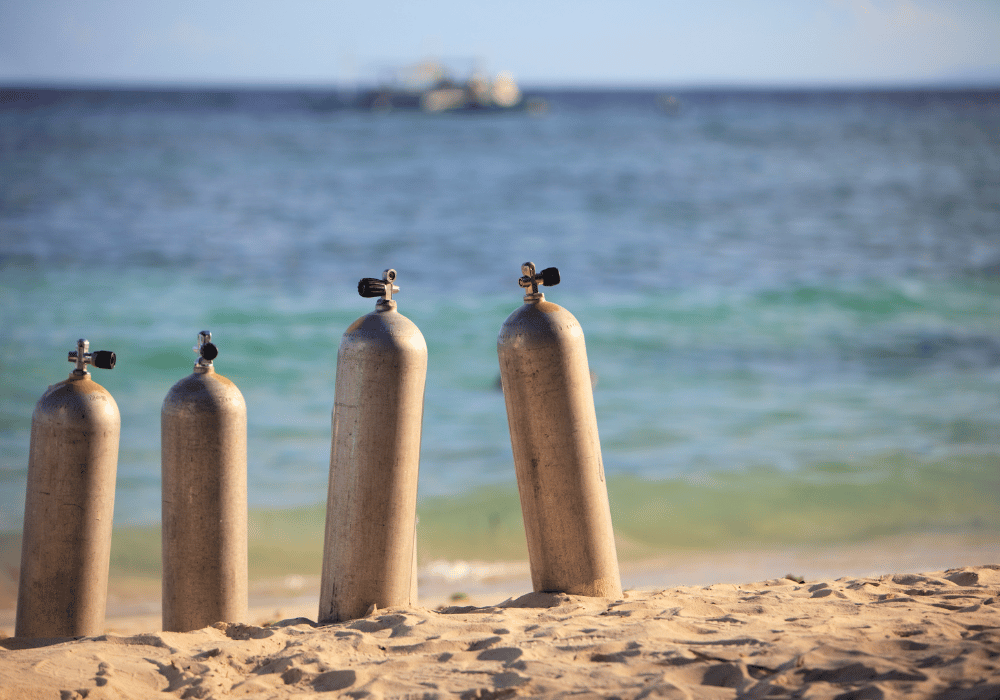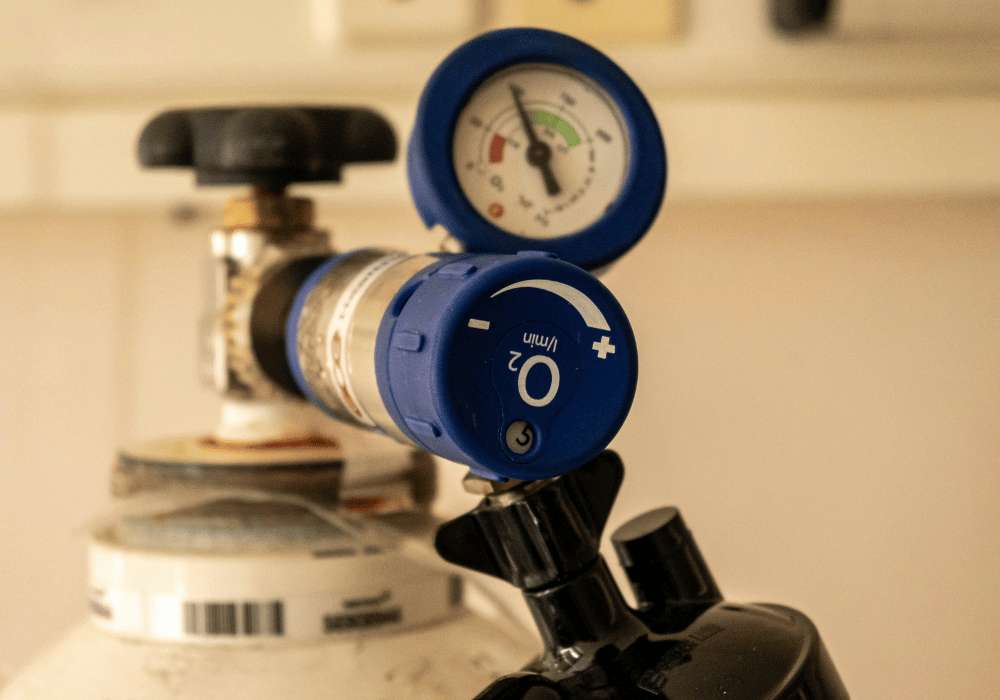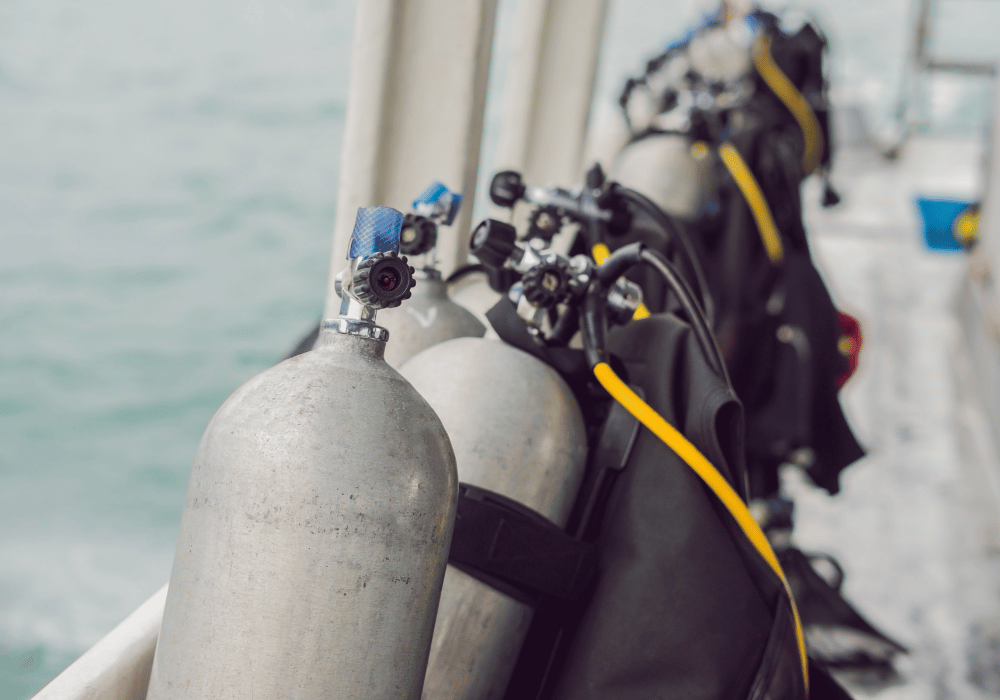Shop Online

Scuba diving opens up an underwater world of adventure, but your safety and enjoyment depend heavily on understanding your equipment. Among all your scuba gear, your air tank serves as your lifeline beneath the surface. Whether you’re planning shallow reef dives or deep wreck explorations, knowing how air tank capacity and pressure ratings work will help you make informed decisions about your equipment and dive planning.
This comprehensive guide breaks down everything you need to know about air tank specifications. You’ll learn how to calculate your air consumption, choose the right tank for different diving scenarios, and maintain your equipment for years of safe diving. From understanding the basics of tank capacity to mastering pressure calculations, these insights will enhance both your safety and confidence underwater.

Air tank capacity refers to the internal volume of your scuba tank, typically measured in cubic feet or litres. This measurement tells you exactly how much compressed air your tank can hold when filled to its working pressure. Most recreational divers encounter tanks ranging from 63 cubic feet for compact travel tanks up to 120 cubic feet for extended dive operations.
The relationship between tank size and dive time isn’t straightforward because your air consumption varies based on multiple factors. A larger tank doesn’t automatically guarantee longer dive times if you’re breathing heavily due to exertion, cold water, or excitement. However, understanding capacity helps you estimate your air supply and plan accordingly for different diving conditions.
Common air tank sizes serve different purposes in the diving world. The popular 80 cubic foot aluminum tank strikes an excellent balance between air supply and portability, making it ideal for most recreational diving. Steel tanks of similar capacity often provide slightly more air due to their construction properties, while maintaining better buoyancy characteristics throughout the dive. Smaller tanks work well for shallow photography dives or as backup air supplies, whereas larger capacity tanks excel during deep dives or when supporting underwater work projects.
Pressure rating indicates the maximum safe working pressure your air tank can handle, typically measured in pounds per square inch (PSI). Standard aluminum tanks usually operate at 3000 PSI, while many steel tanks handle higher pressures of 3442 PSI or even 3500 PSI. These ratings aren’t arbitrary numbers but carefully engineered specifications that ensure your tank operates safely under normal diving conditions.
Higher pressure ratings directly translate to more air storage capacity within the same physical tank size. A steel tank rated for 3442 PSI holds significantly more air than an aluminum tank of identical internal volume rated for 3000 PSI. This relationship explains why many experienced divers prefer high-pressure steel tanks despite their higher initial cost and weight considerations.
Understanding your tank’s pressure rating helps you maximize your air supply while maintaining safety margins. Most dive operators fill tanks to their rated pressure, but environmental factors like temperature affect these pressures. A tank filled to 3000 PSI in an air-conditioned dive shop may show lower pressure readings when cooled by cold water during your dive, which is perfectly normal and expected behaviour.
Accurate air consumption calculations form the foundation of safe dive planning and proper equipment selection. Your Surface Air Consumption (SAC) rate measures how much air you consume per minute at the surface, typically expressed in PSI per minute for your specific tank. To calculate your SAC rate, record your starting and ending tank pressures, note your dive time and maximum depth, then apply the formula that accounts for pressure changes at depth.
Start by subtracting your ending pressure from your starting pressure to find your total air consumption during the dive. Divide this number by your total dive time to get your consumption rate at depth. Then divide by the pressure factor for your maximum depth to determine your surface consumption rate. For example, if you consumed 1500 PSI during a 30-minute dive to 60 feet, your depth consumption rate is 50 PSI per minute, and your surface rate is approximately 25 PSI per minute.
Tracking your SAC rate over multiple dives reveals important patterns about your breathing efficiency. New divers typically consume air faster due to excitement and inefficient breathing patterns, while experienced divers develop more relaxed breathing that conserves air. Environmental factors like cold water, strong currents, or strenuous activities increase air consumption, so factor these variables into your dive planning calculations.

Selecting the appropriate air tank involves balancing multiple factors specific to your diving style and conditions. Your calculated SAC rate provides the foundation for tank selection, but consider dive depth, planned bottom time, safety margins, and transportation requirements. Deep dives naturally require larger air supplies due to increased consumption rates at pressure, while shallow reef dives might allow smaller, more maneuverable tanks.
Tank material significantly impacts your diving experience beyond just air capacity. Aluminum tanks start neutrally buoyant when full and become increasingly buoyant as you consume air, potentially requiring additional weight at the beginning of your dive. Steel tanks typically start negatively buoyant and maintain better trim throughout the dive, often allowing you to reduce the amount of lead weight you carry.
Consider your travel requirements when selecting tanks for different diving destinations. Many tropical dive operations provide aluminum 80s as standard equipment, making these tanks familiar and readily available worldwide. However, if you’re diving locally or own your equipment, investing in high-pressure steel tanks often provides better long-term value through increased capacity and improved buoyancy characteristics.
Regular air tank maintenance ensures reliable performance and extends equipment life significantly. Visual inspections should occur annually, examining the tank interior for corrosion, contamination, or damage that could compromise structural integrity. Professional hydrostatic testing every five years verifies that your tank maintains its pressure rating and operates within safe parameters established by manufacturing standards.
Proper handling prevents damage that could create dangerous situations underwater. Never allow tanks to roll freely or strike hard surfaces, as impacts can weaken the tank structure or damage the valve assembly. Store tanks with some residual pressure to prevent moisture infiltration, and ensure valve caps are installed during transport to protect the delicate valve threads and O-ring seals.
Understanding your personal limits and maintaining conservative air management practices keeps you safe during every dive. Plan your air consumption to surface with at least 500 PSI remaining, allowing adequate reserves for unexpected situations or helping a buddy in need. Monitor your pressure gauge regularly throughout the dive, and establish clear communication signals with your dive buddy regarding air supply status and any concerns that arise during the dive.
Mastering air tank capacity and pressure ratings transforms you from a casual participant into a knowledgeable diver who makes informed equipment decisions. Understanding these fundamentals allows you to select appropriate tanks for different diving conditions, calculate accurate air consumption rates, and maintain your equipment for years of reliable service. These skills directly translate into longer, safer, and more enjoyable diving experiences.
Your journey toward becoming a more competent diver continues with hands-on experience using different tank configurations and tracking your personal air consumption patterns. Consider working with experienced divers or dive professionals who can provide personalized recommendations based on your specific diving goals and local conditions. Regular practice with air management skills builds the confidence and expertise that separate good divers from great ones. Ready to upgrade your diving equipment with quality air tanks that match your specific needs? Benthic Scuba offers an extensive selection of aluminum and steel tanks from trusted manufacturers, along with expert guidance to help you make the right choice for your diving adventures. Reach out today to discuss your requirements and discover how the right air tank can enhance your underwater experiences.
